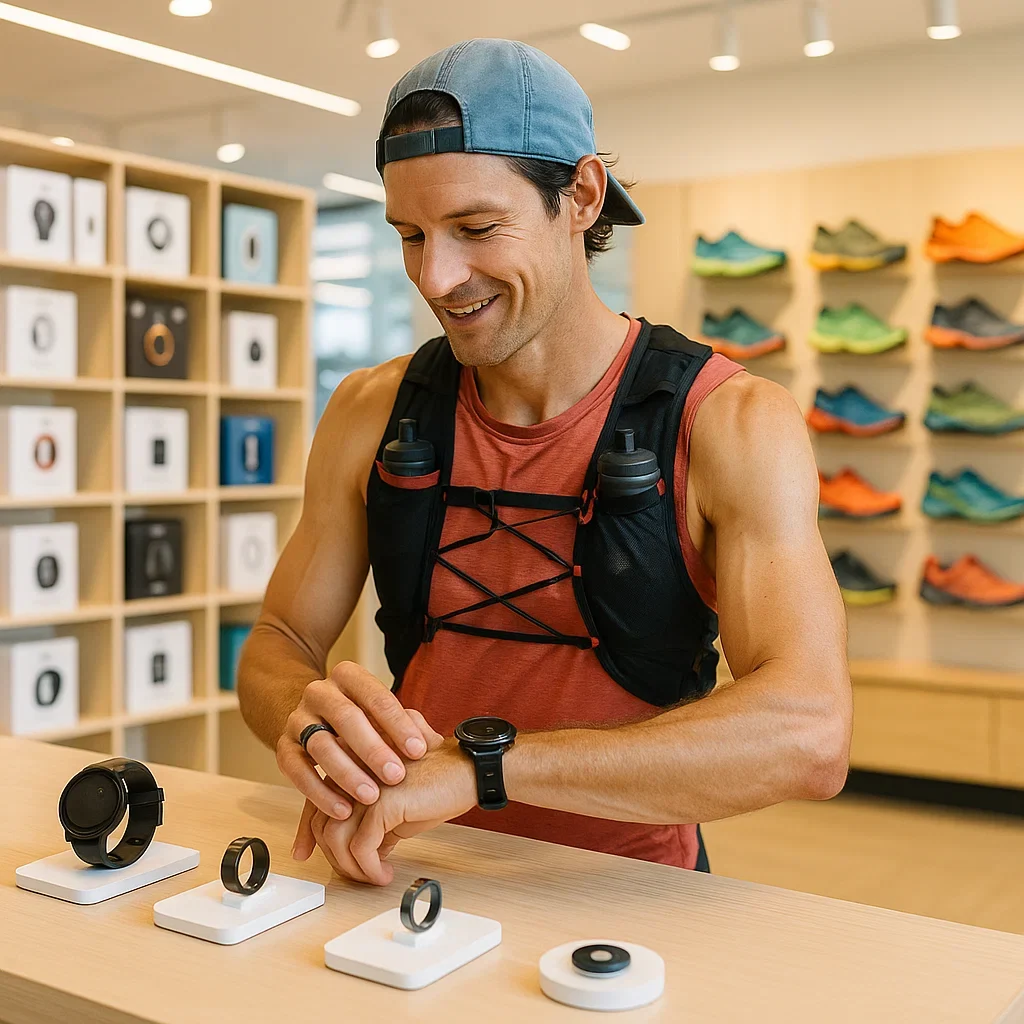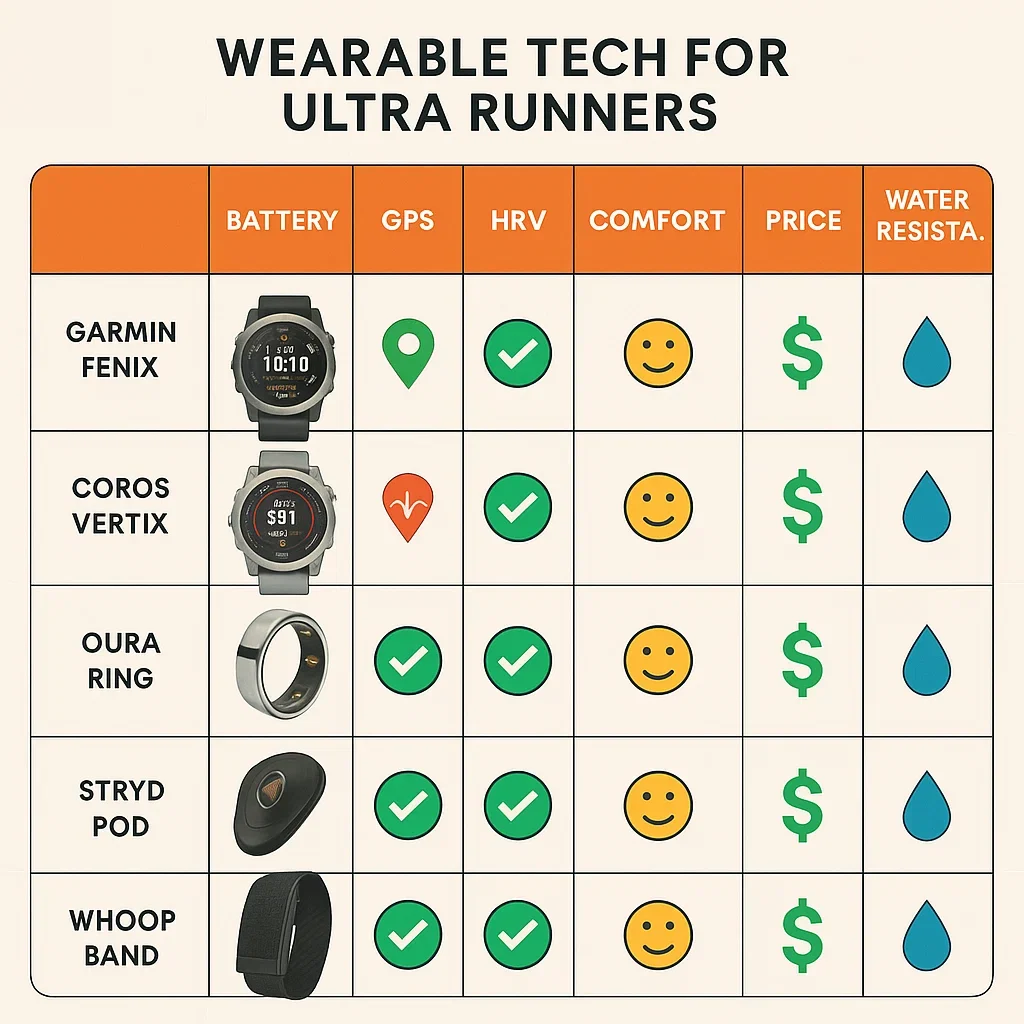How to Choose the Best Wearable Tech for Ultra Runners (2025 Guide)
The right tech can make or break your ultra marathon adventure.
Whether you’re shopping for your first GPS watch or leveling up with a smart ring and running pod, knowing what matters most will help you avoid costly mistakes.
This 2025 guide breaks down must-have features, device types, and real-world tips—so you pick the best wearable for your goals, trails, and budget.
Ready to shop like a pro? Here’s your roadmap to ultra running tech success!
This 2025 guide breaks down must-have features, device types, and real-world tips—so you pick the best wearable for your goals, trails, and budget.
Ready to shop like a pro? Here’s your roadmap to ultra running tech success!
🎯 Why Wearable Tech Matters for Ultras
- Real-time feedback keeps you from overpacing, underfueling, or getting lost
- Long battery and durable build mean fewer worries during 30+ hour races
- HRV, sleep, and recovery data help you plan effort—not just react to fatigue
- Navigation, SOS, and weather features can be lifesavers in remote events
- Sync with training apps, coaches, and communities for smarter, safer running
🔎 Key Features to Look For in 2025
- Battery life: Minimum 24h full GPS, 40h+ for 100 milers
- Multi-GNSS GPS and altitude/barometric sensors
- HRV & heart rate tracking (rest, run, recovery)
- Waterproof (at least 5ATM) and rugged design
- Comfortable fit for small wrists, no-chafe straps
- Easy sync to Strava, Stryd, Oura, Whoop, TrainingPeaks
- Navigation: Color mapping, breadcrumb, and route upload
- Smart alerts: weather, SOS, fall detection (premium models)
🕒 Watch, Ring, Pod, or Band? Pros & Cons
- Watch: Best for GPS, navigation, all-in-one data, ultra battery
- Ring: Super comfortable, ideal for HRV, sleep, daily readiness
- Pod: Most accurate running power (Stryd), shoe-based, no wrist needed
- Band: 24/7 HRV and recovery (Whoop), light, app-based, subscription
🎯 Matching Tech to Your Ultra Goals
- 100K/100 mile: Prioritize battery, rugged build, accurate navigation (Coros Vertix, Garmin Fenix/Epix)
- Mountain/fell: Barometric altimeter, storm alerts, and topo maps are musts
- Multi-day stage races: Quick charging, modular power banks, all-day comfort
- Fastpacking or unsupported: Emergency SOS, weather alerts, solar charging
- Training cycles: HRV/sleep ring, Stryd for power, Whoop for 24/7 recovery
🔋 Battery Life, Durability & Weather Resistance
- Look for minimum 24-48 hours battery in GPS mode
- Sapphire glass, titanium, and reinforced plastic add toughness for falls, scrapes, and weather
- Water resistance: 5ATM (watches), full sweat/shower proof (rings, pods, bands)
- Check device ratings for –20°C to +50°C if racing in extreme conditions
- Field-test charging cables, power banks, and straps before race day
🧤 Comfort, Fit, and Ease of Use
- Try on devices before buying—fit matters over long hours
- Look for soft, hypoallergenic straps and low-profile cases
- Touchscreen vs. button control: what’s easiest with gloves, sweat, rain?
- Check display readability in sunlight and at night
- Practice basic operations (map zoom, lap, charging) before race day
💰 Price Guide: Budget vs Premium
- Budget options: Coros Pace 3 (~$229), Garmin Forerunner 255 (~$349), basic Stryd (~$229)
- Premium watches: Garmin Fenix/Epix 7 ($699–$999), Coros Vertix 2 ($699), Apple Watch Ultra 2 ($799)
- Smart rings: Oura Gen 3 (~$299), Ultrahuman Ring Air (~$349)
- Bands/Pods: Whoop 4.0 (subscription), Stryd Next Gen (advanced power features, $299+)
- Premium isn’t always better—prioritize features and fit over brand name
🏆 Best Devices by Category (2025 Picks)
- GPS Watch (Ultra Battery): Coros Vertix 2, Garmin Fenix 7/Epix Pro
- Navigation & Mapping: Garmin Epix 2, Fenix 7, Apple Watch Ultra 2
- Running Power: Stryd Next Gen Pod
- Sleep & HRV: Oura Ring Gen 3, Ultrahuman Ring Air, Whoop 4.0
- Budget All-Rounder: Coros Pace 3, Garmin Forerunner 255
- Most Comfortable: Smart ring + pod combo (Oura + Stryd)
💬 Ultra Runner Testimonials
- Olivia R.: “My Coros Vertix lasted two full days in the Alps—never worried about battery!”
- Karl S.: “Stryd pod + Oura ring gives me the most reliable recovery and power data. Simple and light!”
- Priya D.: “Garmin’s mapping saved me during a foggy night section—worth every penny.”
❓ Mini-FAQ: Wearable Tech Shopping for Ultra Runners
What’s the most important feature for a first ultra?
Battery life and ease of use. You need a device that won’t die mid-race and is simple to operate.
Is it worth using more than one device?
For data-driven runners: yes! Many pros use a watch for navigation + a pod/ring for power/HRV/recovery.
Are premium devices more durable?
Usually—premium models have better materials, screens, and water/weather sealing. But care and maintenance matter too.
What about warranty and after-sales support?
Major brands like Garmin, Coros, Oura, and Stryd offer reliable support. Always register your device!
🔗 Further Reading & Resources
AI Coaching & Wearable Tech in Ultramarathon
How to integrate AI, apps, and sensors for your best race. Stryd Critical Power Explained
All about running power and long-distance pacing. Coros vs Garmin for 100 Mile Ultras
Which GPS watch is best for ultra distances? Best HRV Apps for Ultra Runners
Smart recovery and readiness for ultra athletes.
How to integrate AI, apps, and sensors for your best race. Stryd Critical Power Explained
All about running power and long-distance pacing. Coros vs Garmin for 100 Mile Ultras
Which GPS watch is best for ultra distances? Best HRV Apps for Ultra Runners
Smart recovery and readiness for ultra athletes.
🏁 Final Thoughts: Make Every Step Smarter
Ultra running tech in 2025 is more advanced—and more personal—than ever.
Whether you want every metric or just peace of mind, choose devices that fit *your* needs, *your* races, and *your* style.
The best wearable is the one you forget you’re wearing—except when you need it most.
Have a gear tip or tech horror story? Share below—or browse our other guides to run smarter, further, and happier!
The best wearable is the one you forget you’re wearing—except when you need it most.
Have a gear tip or tech horror story? Share below—or browse our other guides to run smarter, further, and happier!


About the Author
Lost Pace is an ultramarathon runner, shoe-tester and the founder of umit.net. Based year-round in Türkiye’s rugged Kaçkar Mountains, he has logged 10,000 + km of technical trail running and completed multiple 50 K–100 K ultras.
Blending mountain grit with data, Lost analyses power (CP 300 W), HRV and nutrition to craft evidence-backed training plans. He has co-written 260 + long-form guides on footwear science, recovery and endurance nutrition, and is a regular beta-tester of AI-driven coaching tools.
When he isn’t chasing PRs or testing midsoles, you’ll find him sharing peer-reviewed research in plain English to help runners train smarter, stay healthier and finish stronger.
Ultrarunner · Data geek · Vegan athlete

